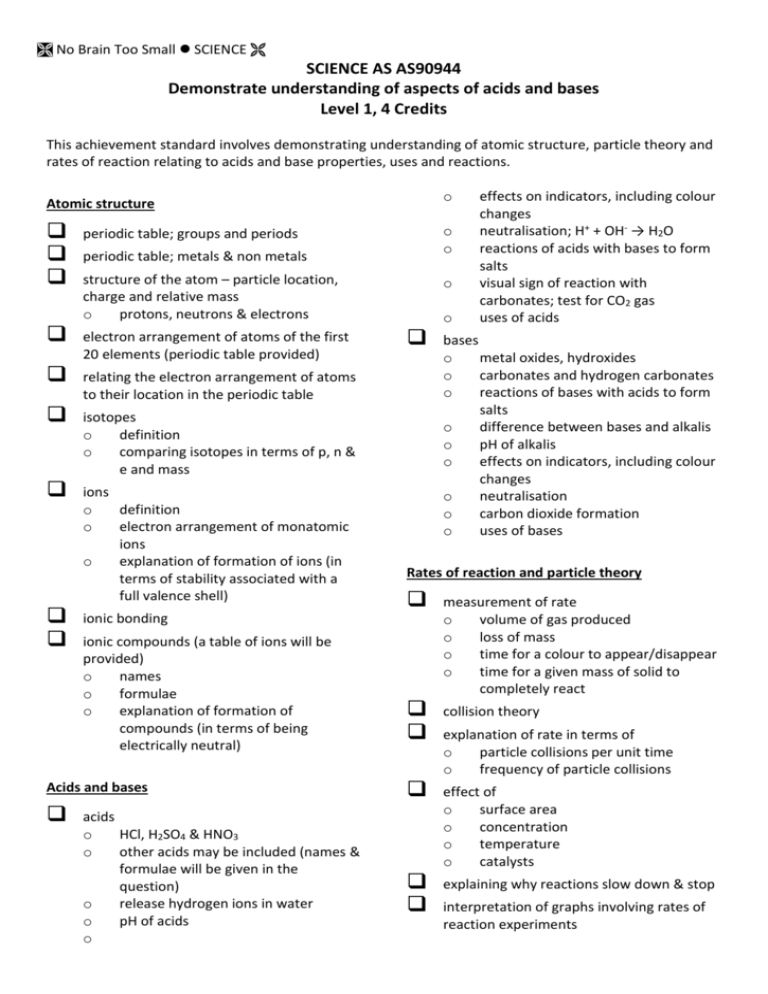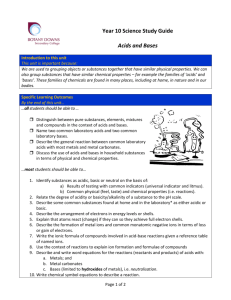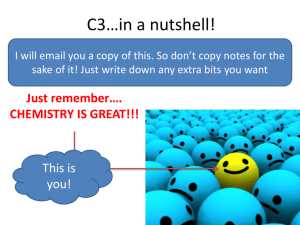SCIENCE AS 90944 OVERVIEW
advertisement

No Brain Too Small SCIENCE SCIENCE AS AS90944 Demonstrate understanding of aspects of acids and bases Level 1, 4 Credits This achievement standard involves demonstrating understanding of atomic structure, particle theory and rates of reaction relating to acids and base properties, uses and reactions. o Atomic structure periodic table; metals & non metals structure of the atom – particle location, charge and relative mass o protons, neutrons & electrons electron arrangement of atoms of the first 20 elements (periodic table provided) o o relating the electron arrangement of atoms to their location in the periodic table isotopes o definition o comparing isotopes in terms of p, n & e and mass ions o definition o electron arrangement of monatomic ions o explanation of formation of ions (in terms of stability associated with a full valence shell) ionic compounds (a table of ions will be provided) o names o formulae o explanation of formation of compounds (in terms of being electrically neutral) acids o HCl, H2SO4 & HNO3 o other acids may be included (names & formulae will be given in the question) o release hydrogen ions in water o pH of acids o bases o metal oxides, hydroxides o carbonates and hydrogen carbonates o reactions of bases with acids to form salts o difference between bases and alkalis o pH of alkalis o effects on indicators, including colour changes o neutralisation o carbon dioxide formation o uses of bases Rates of reaction and particle theory ionic bonding Acids and bases o o periodic table; groups and periods effects on indicators, including colour changes neutralisation; H+ + OH- → H2O reactions of acids with bases to form salts visual sign of reaction with carbonates; test for CO2 gas uses of acids measurement of rate o volume of gas produced o loss of mass o time for a colour to appear/disappear o time for a given mass of solid to completely react collision theory explanation of rate in terms of o particle collisions per unit time o frequency of particle collisions effect of o surface area o concentration o temperature o catalysts explaining why reactions slow down & stop interpretation of graphs involving rates of reaction experiments No Brain Too Small SCIENCE Chemistry vocabulary o symbols and conventions (including names and formulae) o completing word equations o completing given symbol equations o writing balanced symbol equations o graphical interpretations Table of ions +1 +2 +3 NH4+ Ca2+ Na+ Mg2+ K+ –3 –2 –1 Al3+ O2– OH– Fe3+ S2– Cl– Cu2+ CO32– NO3– Ag+ Pb2+ SO42– HCO3– H+ Fe2+ Li+ Ba2+ Zn2+ Periodic Table Will show group numbers, atomic number and element symbol only – as shown in the sample below










